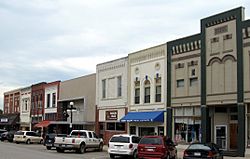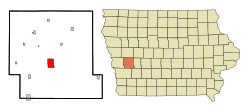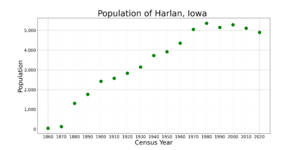Harlan, Iowa facts for kids
Quick facts for kids
Harlan, Iowa
|
|
|---|---|

Downtown Harlan
|
|

Location of Harlan, Iowa
|
|
| Country | |
| State | |
| County | Shelby |
| Area | |
| • Total | 4.42 sq mi (11.45 km2) |
| • Land | 4.42 sq mi (11.45 km2) |
| • Water | 0.00 sq mi (0.00 km2) |
| Elevation | 1,273 ft (388 m) |
| Population
(2020)
|
|
| • Total | 4,893 |
| • Density | 1,107.26/sq mi (427.48/km2) |
| Time zone | UTC-6 (Central (CST)) |
| • Summer (DST) | UTC-5 (CDT) |
| ZIP codes |
51537, 51593
|
| Area code(s) | 712 |
| FIPS code | 19-34500 |
| GNIS feature ID | 468007 |
Harlan is a city in Iowa, USA. It is the main city and the county seat of Shelby County, Iowa. The city is located along the West Nishnabotna River. In 2020, about 4,893 people lived in Harlan.
Contents
Harlan's History
Harlan was first planned out in 1858. It was named after James Harlan, who was an important U.S. Senator from Iowa. In 1859, Harlan was chosen to be the county seat. This means it became the center for the county's government. The town officially became a city on May 2, 1879.
Harlan's Geography
Harlan covers an area of about 4.39 square miles (11.45 square kilometers). All of this area is land.
Harlan's Climate and Weather
Harlan has a climate with warm summers and cold winters. You can see more details about the weather in the table below.
| Climate data for Harlan, Iowa, 1991–2020 normals, extremes 1899–2016 | |||||||||||||
|---|---|---|---|---|---|---|---|---|---|---|---|---|---|
| Month | Jan | Feb | Mar | Apr | May | Jun | Jul | Aug | Sep | Oct | Nov | Dec | Year |
| Record high °F (°C) | 68 (20) |
71 (22) |
90 (32) |
94 (34) |
106 (41) |
107 (42) |
114 (46) |
111 (44) |
106 (41) |
94 (34) |
80 (27) |
68 (20) |
114 (46) |
| Mean maximum °F (°C) | 51.5 (10.8) |
57.5 (14.2) |
73.3 (22.9) |
85.3 (29.6) |
88.8 (31.6) |
93.4 (34.1) |
94.4 (34.7) |
93.4 (34.1) |
89.9 (32.2) |
82.5 (28.1) |
68.2 (20.1) |
53.0 (11.7) |
96.5 (35.8) |
| Mean daily maximum °F (°C) | 30.7 (−0.7) |
35.7 (2.1) |
49.9 (9.9) |
63.3 (17.4) |
74.1 (23.4) |
83.6 (28.7) |
85.9 (29.9) |
84.0 (28.9) |
78.5 (25.8) |
65.4 (18.6) |
49.3 (9.6) |
35.9 (2.2) |
61.4 (16.3) |
| Daily mean °F (°C) | 20.5 (−6.4) |
24.7 (−4.1) |
37.6 (3.1) |
49.8 (9.9) |
61.7 (16.5) |
71.7 (22.1) |
74.7 (23.7) |
72.4 (22.4) |
65.1 (18.4) |
52.2 (11.2) |
37.6 (3.1) |
25.8 (−3.4) |
49.5 (9.7) |
| Mean daily minimum °F (°C) | 10.3 (−12.1) |
13.7 (−10.2) |
25.3 (−3.7) |
36.4 (2.4) |
49.3 (9.6) |
59.9 (15.5) |
63.6 (17.6) |
60.8 (16.0) |
51.7 (10.9) |
39.1 (3.9) |
25.9 (−3.4) |
15.7 (−9.1) |
37.6 (3.1) |
| Mean minimum °F (°C) | −10.1 (−23.4) |
−7.4 (−21.9) |
5.9 (−14.5) |
21.1 (−6.1) |
35.7 (2.1) |
46.9 (8.3) |
51.7 (10.9) |
49.7 (9.8) |
34.9 (1.6) |
22.9 (−5.1) |
9.1 (−12.7) |
−6.5 (−21.4) |
−16.1 (−26.7) |
| Record low °F (°C) | −37 (−38) |
−37 (−38) |
−23 (−31) |
2 (−17) |
18 (−8) |
31 (−1) |
40 (4) |
35 (2) |
20 (−7) |
0 (−18) |
−16 (−27) |
−27 (−33) |
−37 (−38) |
| Average precipitation inches (mm) | 0.90 (23) |
0.98 (25) |
2.05 (52) |
3.34 (85) |
4.74 (120) |
5.17 (131) |
3.72 (94) |
4.32 (110) |
4.00 (102) |
2.37 (60) |
1.43 (36) |
1.31 (33) |
34.33 (871) |
| Average snowfall inches (cm) | 7.6 (19) |
7.6 (19) |
4.0 (10) |
1.5 (3.8) |
0.0 (0.0) |
0.0 (0.0) |
0.0 (0.0) |
0.0 (0.0) |
0.0 (0.0) |
0.9 (2.3) |
2.2 (5.6) |
6.7 (17) |
30.5 (76.7) |
| Average precipitation days (≥ 0.01 in) | 5.8 | 6.7 | 7.4 | 10.9 | 12.2 | 11.1 | 8.7 | 8.8 | 7.3 | 7.5 | 5.7 | 6.2 | 98.3 |
| Average snowy days (≥ 0.1 in) | 4.6 | 5.0 | 2.1 | 0.9 | 0.0 | 0.0 | 0.0 | 0.0 | 0.0 | 0.3 | 1.8 | 4.4 | 19.1 |
| Source 1: NOAA | |||||||||||||
| Source 2: National Weather Service (mean maxima/minima 1981–2010) | |||||||||||||
Harlan's Population and People
Harlan's population has changed over the years. You can see how the number of people living in Harlan has grown and shrunk in the table below.
| Historical populations | ||
|---|---|---|
| Year | Pop. | ±% |
| 1860 | 47 | — |
| 1870 | 128 | +172.3% |
| 1880 | 1,304 | +918.8% |
| 1890 | 1,765 | +35.4% |
| 1900 | 2,422 | +37.2% |
| 1910 | 2,570 | +6.1% |
| 1920 | 2,831 | +10.2% |
| 1930 | 3,145 | +11.1% |
| 1940 | 3,727 | +18.5% |
| 1950 | 3,915 | +5.0% |
| 1960 | 4,350 | +11.1% |
| 1970 | 5,049 | +16.1% |
| 1980 | 5,357 | +6.1% |
| 1990 | 5,148 | −3.9% |
| 2000 | 5,282 | +2.6% |
| 2010 | 5,106 | −3.3% |
| 2020 | 4,893 | −4.2% |
| Source: and Iowa Data Center Source: |
||
Harlan's 2020 Census Data
In 2020, the city of Harlan had 4,893 people living there. There were 2,288 households, which are groups of people living in one home. About 1,275 of these were families. The population density was about 1,111 people per square mile. This means how many people live in a certain area.
Most people in Harlan (90.8%) were White. Other groups included African American (0.8%), Native American (0.5%), and Asian (0.8%). About 4.6% of the people were Hispanic or Latino.
About 21.5% of households had children under 18. Many households (45.3%) were married couples. The average age of people in Harlan was 47.4 years old. About 20.3% of residents were under 18.
Harlan's 2010 Census Data
In 2010, Harlan had 5,106 people. There were 2,222 households and 1,341 families. The population density was about 1,163 people per square mile.
Most people (97.0%) were White. Other groups included African American (0.5%), Native American (0.4%), and Asian (0.6%). About 1.9% of the people were Hispanic or Latino.
About 26.7% of households had children under 18. The average age was 43.8 years. About 23.8% of residents were under 18.
Harlan's Economy
A big employer in Harlan is CDS Global. This company helps manage subscriptions for many magazines and newspapers. So, you might see a Harlan P.O. box as the customer service address for a magazine.
Harlan's Education
Schools in Harlan
The public schools in Harlan are managed by the Harlan Community School District. This district also serves students from nearby towns like Jacksonville and Defiance.
As of November 2021, about 1,450 students were enrolled in the district. Most students (91.4%) were White, and 5.7% were Hispanic.
The district has four schools, all located in Harlan:
- Harlan Primary School (for grades K-2)
- Harlan Intermediate School (for grades 3-5)
- Harlan Community Middle School (for grades 6-8)
- Harlan Community High School (for grades 9-12)
There is also a private school called Shelby County Catholic School. It is connected to St. Michael's Catholic Church and is the only private school in Harlan.
Notable People from Harlan
- Johnny Beauchamp, a NASCAR race car driver
- Mary Lincoln Beckwith, a great-grandchild of Abraham Lincoln
- Howard Webster Byers, who was Iowa's Attorney General
- Susan Christensen, a Chief Justice on the Iowa Supreme Court
- Billy Cundiff, an NFL football kicker
- Zach Daeges, a baseball outfielder
- George Sabin Gibbs, a United States Army General
- Albert Hansen, a college football coach
- Kij Johnson, an author
- Greg Lansing, a former basketball coach for Indiana State Sycamores men's basketball
- Jerry L. Larson, an Iowa Supreme Court Justice
- Tiny Lund (1929–1975), a NASCAR driver who won the Daytona 500 in 1963
- Raymond Eugene Plummer, a lawyer and judge
- Lynn Reynolds, a film director
See also
 In Spanish: Harlan (Iowa) para niños
In Spanish: Harlan (Iowa) para niños


